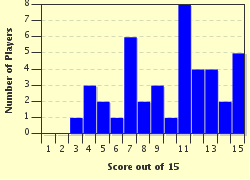Quiz Answer Key and Fun Facts
1. The conurbation usually referred to as Weymouth, is actually a municipal borough formed of two towns; Weymouth which lies upon the southern bank of the River Wey and its 'twin' on the northern bank. This north bank town was historically known as ____ Regis?
2. This body of water is situated just to the north of Weymouth's inner harbour. What leisure activity can be pursued within the environs of Radipole Lake?
3. Situated on Weymouth's magnificent Georgian promenade, what was erected there to commemorate the golden jubilee of Queen Victoria in 1887?
4. Over the years Weymouth has been used as a location for a number of film productions. In 1961 the town was the location for this psychological thriller which starred the actor Oliver Reed. Which film was this?
5. With a name used loosely in a novel by J. Meade Falkner, what name is given to the narrow, shallow tidal lagoon that lies between Chesil Beach and the mainland?
6. Many are familiar with the name 'Portland Bill', which is the name given to the southern tip of the island of Portland. What ecclesiastical name is given to the massive rock perched precariously above the sea on the cliffs below Portland Bill lighthouse?
7. This is a relic from the time of the English Civil War and, provided you keep your eyes open, it can be seen on a walk taken through the old part of the port of Weymouth?
8. During the fourteenth century, the Black Death entered into England through Weymouth's twin port and brought such calamity to the rest of the country?
9. One of the town's most impressive historic monuments is located at the junction of two of the town's main thoroughfares. Known as the King's Statue, which king does this monument commemorate?
10. Beginning early in February 2016, attempts are being made to obtain legal protection for which world famous local product?
11. In 1539 King Henry VIII commanded the construction of what, the remains of which still overlook Portland harbour today?
12. This second fort, was initially constructed to defend the entrance to the highly important ports of Weymouth and Melcombe Regis in response to aggressive tendencies being displayed by which of England's 'natural' enemies?
13. Considering Weymouth's sheltered location on the southern coast, which events were held there during the 2012 London Olympics?
14. Portland harbour, the Causeway and the Fleet all benefit from the protection provided by a total of four massive stone piers. What name is given to these impressive examples of engineering?
15. The 'Race' is a name given locally to a triangular area of turbulent sea immediately to the south of Portland Bill. This area is more turbulent than the areas that surround it because of unique disturbances in 'the force'?
Source: Author
SisterSeagull
This quiz was reviewed by FunTrivia editor
bloomsby before going online.
Any errors found in FunTrivia content are routinely corrected through our feedback system.

